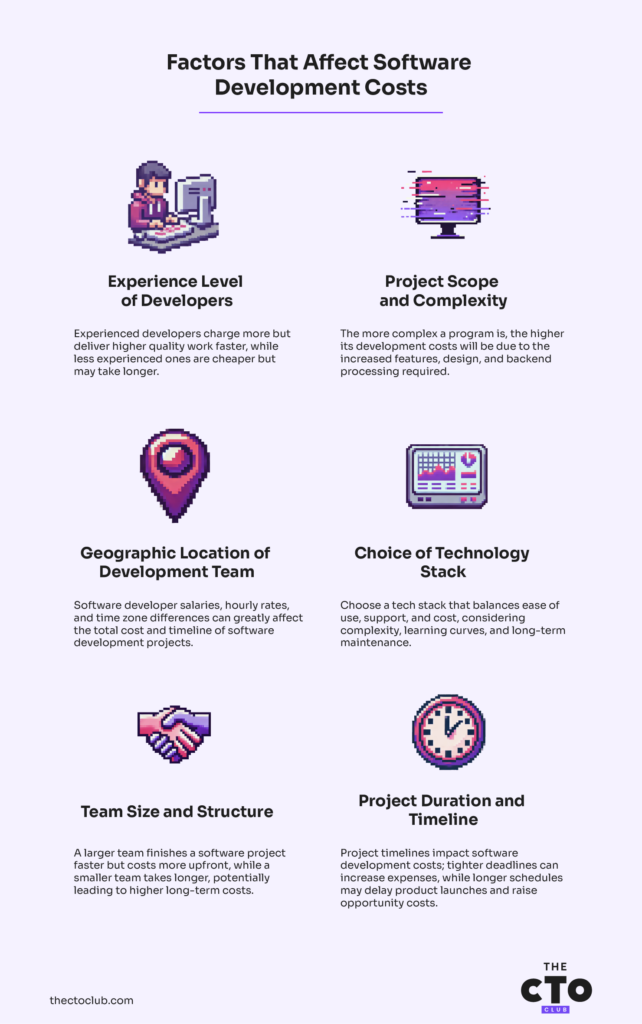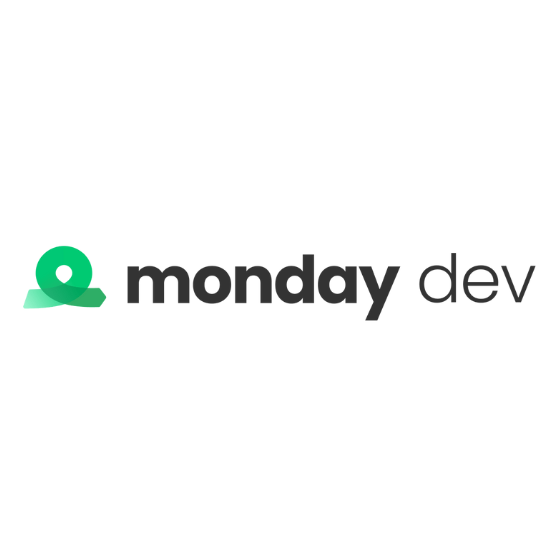Looking for ways to reduce software development costs without compromising on quality? You're not alone. Cutting development expenses while still delivering reliable, high-performing software is a top priority for many tech companies and startups.
To achieve this, it’s crucial to understand what drives up development costs and how aligning your business goals with the right tools, teams, and technologies can lead to significant savings.
In this guide, we’ll break down the main cost factors and share actionable strategies to streamline your process and maximize value at every stage of development.
Factors That Can Reduce Software Development Costs
Before having a plan for software development cost reduction, you must first understand what determines the costs and where it makes sense to adjust expenses.

Experience Level of Developers
Not surprisingly, more experienced developers have higher rates than those with less experience. At the same time, professional developers can deliver more qualitative work in less time and can handle complex requirements more easily. However, if you're looking for a low-cost solution, consider hiring someone with less expertise, as they're more likely to charge less for the same job.
Project Scope and Complexity
The degree of complexity of a program will determine its development costs. Simple apps with few functionalities and less backend processing typically have cheaper expenses. On the other hand, complex applications require a larger investment, as they utilize a comprehensive technological stack, intricate algorithms, and substantial backend processing. Several factors contribute to the complexity, including the framework, app features, UI and design, and the level of support documentation.
The costs rise with its complexity, taking into account factors such as architecture, design complexity, and post-deployment maintenance requirements. For example, working with a custom software development company on a bespoke application may be more costly than working on a more generic one.
While a simple app may focus on a small set of operations, a complicated one may include several activities, each of which contributes to the development timeframe and budget.
Geographic Location of Development Team
Software developer salaries can vary significantly by country or region. Their hourly rates can have a significant impact on the overall cost of software development, depending on their proficiency in a specific technology stack.
Timezone differences can also impact the costs. Having teams spread out across different time zones can affect communication and cause delays in task completion, thereby increasing costs.
Choice of Technology Stack
Each programming language, framework, and tool has a varying degree of complexity. They also provide different learning curves and community support. Costs can also be impacted by the availability of programmers for a particular technology. Remember that your tech stack has to balance functionality, scalability, and long-term maintenance expenses.
-

monday dev
Visit WebsiteThis is an aggregated rating for this tool including ratings from Crozdesk users and ratings from other sites.4.6 -

QA Wolf
Visit WebsiteThis is an aggregated rating for this tool including ratings from Crozdesk users and ratings from other sites.4.8 -

GitHub
Visit WebsiteThis is an aggregated rating for this tool including ratings from Crozdesk users and ratings from other sites.4.7
Team Size and Structure
A team with more developers will complete a software project faster than a small team. The greater the team, the more expensive in a shorter time interval since you must pay for each developer's time and skills. However, a smaller team may lead to higher long-term costs, because the work will take more time to complete, and the features will reach the end-users later.
Project Duration and Timeline
An additional factor influencing software development costs is the project's timeline. Shorter deadlines can require more resources to meet them. It may result in increased costs due to overtime or hiring more developers.
A longer schedule, on the other hand, may cause product introductions to be delayed and raise opportunity costs. Finding the right balance between speed and efficiency is critical for efficient cost management.
Strategies to Reduce Software Development Costs
Now that we have a better understanding of the factors that affect the costs, let’s discuss a bit about how to reduce them.
Effective Planning and Requirement Analysis
Before beginning any software development project, you must conduct comprehensive research on the market, user demands, and potential difficulties. This will help in the development of a precise project plan, complete with a clear objective, milestones, and estimates.
With an SRS (Software Requirements Specification) - a document outlining your goals, needs, and system features, you can get an accurate estimate of work time and costs. It is a key aspect of both in-house and outsourced development.
This strategy helps developers avoid misunderstandings and miscommunications about the job, provide a clear project plan, and improve communication between clients and developers. As a result, the final cost will be as near as feasible to the values you intended.
Reusing Existing Components
When developing a product, it's important to try to reuse components and eliminate any unnecessary features. Reusable components are pieces of code that may be reused across several projects.
This will save you time because you will not need to write fresh code for each project. When developing a new feature, avoid making it overly intricate, as this will increase the time necessary for programming. So make sure to hire software engineers who can accomplish this job well.
Choosing the Right Technology Stack
Choosing the correct technology stack or toolset helps cut development expenses by reducing license and maintenance costs. You can save money by avoiding proprietary languages like Java and instead employing open-source languages like Python or Ruby. Every form of programming tool has advantages and disadvantages, therefore you must choose just the tools that are most appropriate for your specific project.
They may be more expensive initially, but they provide long-term benefits such as increased dependability and support from a dedicated team of engineers.
Furthermore, while searching for software development tools, make sure to compare apples to apples—you can't truly assess one product without considering all of its competition.
Outsourcing and Nearshoring Options
One of the most common cost-cutting methods used by modern firms is outsourcing important business operations that lie outside of their area of competence. For example, a small firm may outsource its accounting activities to focus its limited resources on essential business competencies and functions. In this manner, even if a company incurs outsourcing costs, it saves money on labor (hiring, training, and keeping employees) and resources. Customer satisfaction is high because the company fulfills their wants and expectations.
Adopting Agile and DevOps Practices
One of the frameworks that can help reduce costs is Agile. Adopting an agile model allows you and your team to change your project strategy regularly. Agile projects have flexibility if anything unexpected arises during development.
Instead of being bound by a linear timetable with little room for modifications, an agile strategy allows you to adapt while keeping everyone informed. This improves communication and openness among all parties involved, ensuring that everyone agrees with any adjustments that may arise along the road.
So, adopt Scrum or another Agile technique to ensure everyone collaborates well and effectively toward a single goal.
DevOps is another way to optimize the development costs. A core aspect of DevOps is that the practice and culture enable team members to connect better with one another and with customers.
The development team and those in charge of the application's operation have clearly defined responsibilities, which helps you avoid transferring tasks from one team member to another. The DevOps philosophy revolves around continuous integration and delivery (CI/CD).
According to this method, each module developed is gradually incorporated into company operations to analyze its efficacy and solicit feedback. This way, you may prevent a situation in which the application generated does not suit your company's goals and demands.
Prioritizing Features with MVP Approach
Another strategy is to adopt the MVP (Minimum Viable Product) method. In a nutshell, the goal is to deliver a product to the market with the fewest features necessary for the intended audience. The technique will allow you to put your company concept to the test in real-world circumstances, receive immediate feedback and use these insights to develop.
In this strategy, with minimal expenditure, you may have a better understanding of the market position and demand for your goods. The technique will allow you to avoid the unnecessary risks of devoting substantial time and money to building a product with features that your target audience does not require.
Implementing Quality Assurance and Automated Testing
There are several means to assure the quality of the software you develop. One approach is to implement a thorough testing procedure that involves both manual and automated testing. Additionally, a strong code review procedure and sufficient documentation are required.
In addition, it is critical to have a strong quality assurance (QA) staff that can test the program and discover any problems. Finally, a solid DevOps approach is required to ensure successful collaboration between the development and operations teams.
Common Pitfalls to Avoid
It's easy to fall into traps that can ultimately undermine your efforts to reduce IT costs. Cost-cutting measures that seem beneficial at first glance, like opting for fixed-price contracts or neglecting scope management, can lead to poor quality outcomes, missed deadlines, and even higher expenses in the long run. Understanding these common pitfalls and how to avoid them helps maintain budget and quality throughout your development projects.
Let's explore some of the most frequent mistakes and consider my guidance on how to navigate them effectively.
Avoiding Fixed Price Contracts
This method may look appealing since it appears to leave no space for surprises. This working model is appropriate for small projects that are produced in stages using the Waterfall process, allowing for more precise estimates of both necessary time and related prices.
However, if the software development cost is fixed, building a larger project that requires an Agile technique may fail. In this instance, the developers will try not to go over budget, but the product's quality will probably suffer. Furthermore, this technique will not allow for adjustments and adaptations, which are essential components of Agile. A fixed pricing strategy is best suited to basic, predictable tasks.
Managing Scope Creep
Time is the most important resource you have, regardless of your industry. Priorities for each project should be established following the software development company's objectives. Teams may reduce scope creep and rework by establishing objectives and defining processes early in the project lifecycle. Setting priorities involves being practical about what and when will be delivered while maintaining a high degree of quality.
Furthermore, using consistent processes will help reduce misunderstanding and guarantee that everyone is contributing to the same goal.
Ensuring Clear Communication with Vendors
Vendor management is a cost reduction strategy that optimizes and streamlines services like SaaS, IaaS, and other services to better suit company needs. It helps businesses analyze and lower costs by negotiating contracts. Vendors can also be evaluated using this strategy to identify which software brings value to the company and which can be eliminated or negotiated. This includes renegotiating contracts with manufacturers, software resellers, distributors, and system integrators. By focusing on these areas, businesses can save money and improve their overall business operations.
Takeaways
Software development costs are influenced by various factors such as the experience level of developers, project scope and complexity, geographic location of the development team, timezone differences, choice of technology stack, team size and structure, and project duration and timeline.
To reduce costs, effective planning and requirement analysis, reusing existing components, choosing the right technology stack, outsourcing and nearshore software development company options, adopting agile and DevOps practices, prioritizing features with the MVP approach, and implementing quality assurance and automated testing are essential strategies.
Subscribe to our newsletter for more tips and strategies on software development.
FAQs
What are the main factors influencing software development costs?
Some of the most important factors that can affect development costs are:
- Developers’ level of experience
- Complexity of the project
- Geolocation of the team
- Tech stack
- Team structure
How can Agile methodology help in reducing costs?
Agile is a cost-reducing framework that enables regular changes to project strategies, allowing flexibility for unexpected developments. This approach fosters communication and openness among all parties involved, ensuring agreement on adjustments.
What are the benefits of outsourcing software development?
Modern companies often outsource crucial business operations, such as accounting, to focus resources on essential competencies, resulting in cost savings on labor and resources, and increased customer satisfaction as the company fulfills its needs.







